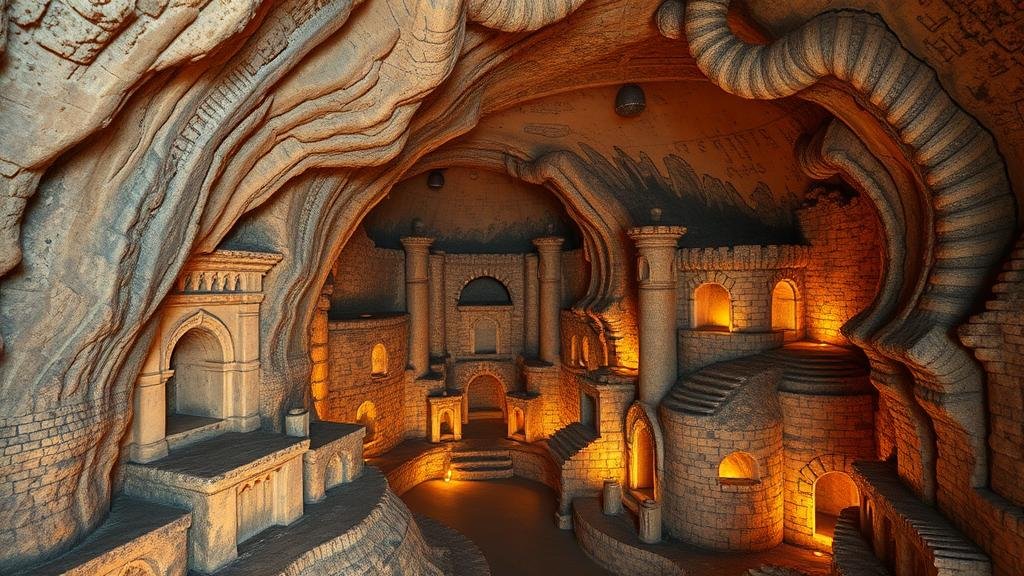Investigating the architectural secrets of subterranean cities.
Investigating the Architectural Secrets of Subterranean Cities
Subterranean cities, often shrouded in mystery, represent a fascinating chapter in the history of architecture. These hidden worlds highlight humanitys ingenuity in overcoming geographical challenges and adapting to environmental threats. This article explores the architectural secrets of such cities, examining their historical context, construction techniques, and their relevance today.
Historical Context of Subterranean Cities
The concept of building underground is not a modern phenomenon. Some of the earliest examples can be traced back to the ancient civilizations of the world. Notably, the Cappadocia region in Turkey boasts ancient underground cities like Derinkuyu and Kaymaklı, which date back to the 8th century BCE. These subterranean structures were initially designed for shelter from invasions and harsh weather conditions.
In total, it is estimated that there are over 200 subterranean cities in Cappadocia alone, many capable of housing thousands of people. cities feature complex systems of tunnels, living quarters, and communal spaces, showcasing advanced engineering for their time.
Construction Techniques of Subterranean Cities
Building underground poses distinct challenges, but ancient engineers mastered several techniques that are still recognized today. The following construction methods are particularly noteworthy:
- Earth Excavation: The skillful removal of earth was essential in creating spacious underground chambers. Early workers used basic tools to hollow out soft volcanic rock, known for its ease of manipulation.
- Ventilation Systems: To ensure a livable atmosphere, ancient engineers developed complex ventilation shafts. systems, resembling modern HVAC setups, facilitated airflow throughout the tunnels, preventing toxic gas buildup and improving air quality.
- Water Management: Managing water supply and drainage was critical. Ingenious drainage systems were built into these cities to avoid flooding while source water was collected and stored in tanks.
Examples of Notable Subterranean Cities
Several subterranean cities illustrate the architectural prowess and creativity of their builders:
- Derinkuyu: As the largest of Cappadocias underground cities, Derinkuyu extends approximately 60 meters underground and could accommodate around 20,000 inhabitants. Its design includes stables, wineries, and chapels, showcasing a diverse utility.
- Montreal’s RESO: This modern subterranean complex emerged in the 1960s as a response to Montreals harsh winters. Spanning over 33 kilometers, RESO connects shopping centers, hotels, and transit stations, demonstrating the practical application of underground architecture in contemporary urban planning.
Modern Applications and Future Potential
Today, subterranean architecture has gained renewed interest, not just for historical preservation but also for addressing contemporary issues like urban overcrowding. Some modern cities are exploring underground options to optimize space, reduce urban heat, and enhance sustainability.
In China, the underground city concept integrated into urban planning as a response to rapid urban sprawl. Shenzhen, for instance, has proposed extensive subterranean developments to relieve surface congestion and create new commercial spaces.
Challenges and Considerations
While constructing subterranean cities presents unique benefits, several challenges are prevalent:
- Structural Integrity: Maintaining the structural soundness of underground buildings is crucial, necessitating advanced engineering and ongoing assessments.
- Accessibility: Navigating large, underground spaces can be complicated. Effective design must consider the flow of foot traffic and emergency exit routes.
- Environmental Impact: Construction activities can disrupt local ecosystems, requiring careful planning and management to mitigate damage to surrounding areas.
Conclusion: The Lasting Legacy of Subterranean Architecture
Subterranean cities serve as a testament to human creativity and adaptability in the face of adversity. From the ancient wonders of Cappadocia to modern urban solutions, these underground marvels continue to inspire architects and urban planners worldwide.
The exploration of subterranean spaces highlights not only our historical narrative but also potential pathways for future development, ensuring that even below the surface, cities can thrive. As urban populations grow, the architectural secrets of our hidden cities may become increasingly vital in shaping sustainable and resilient urban environments.
For those interested in architecture, urban planning, or history, delving into the realm of subterranean cities offers invaluable insights and opportunities for innovation in building design and community planning.



